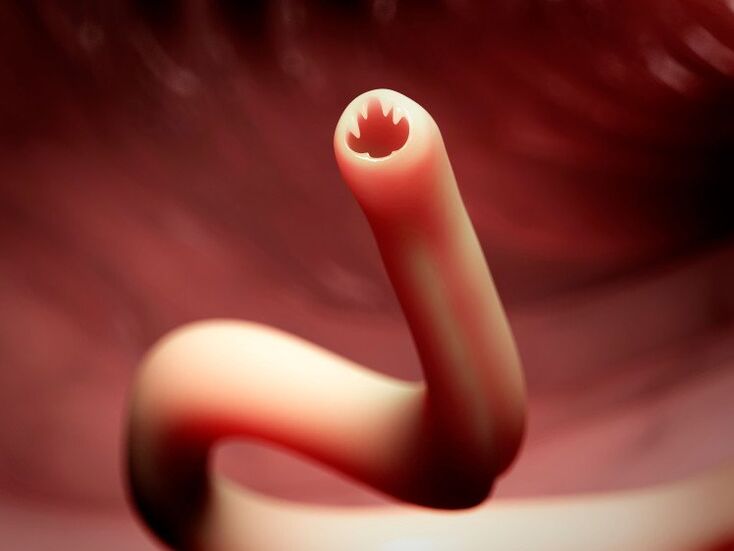
The worms or helminths is a disease that masks its course quite well. Therefore, often a person does not cure a phenomenon that worsens health. Knowing the main signs of worms, you can accurately determine their presence or absence in the body.
The main thing to remember is the correct assessment of the patient's condition and the specificity of the course of the disease. In order for the treatment to proceed in an efficient and timely manner, a detailed study of the manifestations of worms is necessary.
How can you get infected with worms?
Any adult can become a carrier of parasitic worms and a child is also susceptible to infection.
Helminths can enter the body in several ways, namely:
- Water;
- food;
- contact and home;
- autoinfection;
- transmissible.
The first waterway of infection is based on the ingestion of water, which contains worm eggs or larvae. The larvae enter the water through an intermediate host, for example, a mollusk, and only then do they leave their body and develop independently, joining aquatic plants. As soon as the liquid enters the body of a living being, the worm makes its way into the digestive system and is already fixed here.
This process often takes place in rivers, ponds, lakes, springs. To avoid contamination, you should stop drinking water from open sources, especially for children. If the case forces one to absorb such water, then boiling or filtering through a special filter is a prerequisite.
The route of food entry is the main and most common principle of infection. It has a direct connection with non-compliance with basic hygiene or a violation of technologies for preparing meat and fish dishes. Helminth penetrates through dirty hands, vegetables, berries, fruits, etc. Anything grown in the ground can contain worm eggs. They appear there from the feces of patients with ascariasis and live in favorable conditions for them for quite a long period of time. The highest probability of infection is where the soil is fertilized with feces with the presence of roundworm eggs in them.

Larvae found in meat and fish enter the body along with undercooked, not fully cooked food. Once inside a person, the worms eventually develop into an individual capable of laying eggs on its own. It is worth knowing that in 24 hours a worm can produce several hundred thousand new eggs.
In order not to become infected and not to experience the signs of worms, it is necessary to buy meat and fish only in controlled places, pay attention to the presence of veterinary control, examine meat and especially the liver for the presence of worms. Also thoroughly boil (steam, fry) food, properly process kitchen utensils, protect the room from flies that can carry helminth eggs on their paws.
The domestic contact method involves the penetration of worms by contact with household items, animals that carry the larvae of the worms. Statistics show that more than 70% of the entire earth's population was infected with worms, half of this number became infected through contact with pets. This is dangerous because the signs of the presence of worms in animals may not appear at all. But in humans, the symptom of penetration of the helminth is expressed by nausea, constipation, vomiting, pain in the intestines and weight loss.
With regard to autoinfections, children are often susceptible to them, especially those of kindergarten age and younger schoolchildren. Children do not always follow hygiene rules, for example, after going to the bathroom. Helminthic invasion in infants is the development of enterobiasis. Pinworms have very light eggs, so they are transferred to toys, bedding, and furniture by a gust of wind, and they can also enter the body with dust. When worms inside a child or adult reach puberty, they crawl onto the walls of the anus and begin the process of laying eggs. Itching and itching begins, these are the main signs of the penetration of worms. At night, the child can scratch his anus and then put the worms back in his mouth with his hands, in which case the cycle repeats.
Regarding the transmissible infection, it must be said that the infection is caused by the bite of an insect. These can be mosquitoes, gnats, fleas that pets have. Most often, the infection occurs with filaments (filariae).

Symptoms of worms in an adult.
The presence of worms in the body can be recognized by special signs, but they may differ in people.
Such characteristic manifestations of severely infected patients:
- exhaustion;
- weight loss (a sudden downward change in weight);
- pale skin;
- severe itching in the anus.
Depending on where the helminths are and what their number is, a certain symptom develops.
In the brain
The first and main symptom, which implies the presence of worms in the brain, is a general deterioration of well-being, and it is not permanent, but temporary and cyclical. A necessary measure is a photo taken with an ultrasound machine, then the worms in the brain look like a tumor.Additionally, symptoms should include:

- lethargy;
- feeling groggy;
- nausea along with vomiting;
- the disease causes seizures like epilepsy;
- temperature rise for no apparent reason.
These symptoms are generalized; Special studies will help to see the prevailing picture more clearly.
In body
Among all the parasites on Earth, more than 250 varieties of helminths can harm the human body. They can live in almost the entire body: heart, muscles, liver, under the skin, etc.
The symptoms of each case will be different, but there are still a number of common signs.
- weak immune system;
- pain in joints, muscles;
- nervousness;
- fatigue that has become chronic;
- under weight
- deterioration of the skin.
In the intestines
Most of the time, the worms settle in the intestines, it is much easier to penetrate here and multiply in such an environment. You can know the presence of "inhabitants" by:
- constantly recurring swelling;
- Diarrhea;
- weight fluctuations;
- flatulence;
- feeling of constant hunger
Signs of the appearance of worms, as well as how to identify them through tests and other diagnostic methods.
When a person is infected with worms, symptoms may not appear in the initial stage. You can see signs of the appearance of worms at home only when they begin to multiply. The first sign begins when the body is poisoned with toxins, the parasites absorb those nutrients that a person receives with food.

The manifestation of helminths can be due to symptoms such as:
- Diarrhea;
- discomfort in the abdomen;
- flatulence;
- swelling
- stagnation of bile;
- constipation;
- allergic manifestations;
- intestinal inflammation;
- joint and muscle pain;
- dermatitis, eczema;
- brittle nails, skin cracks, skin discoloration;
- anemia;
- weightloss;
- nervous system disorder, anxiety symptom, trouble sleeping;
- grinding your teeth while sleeping;
- excessive fatigue, loss of performance;
- respiratory problems: inflammation, pneumonia, asthma;
- weakening of the immune system;
- oncology (if helminthiasis is not treated for a long time).
Methods for determining worms.
How to determine worms in a person, the doctor knows for sure, as a rule, for this, an examination is carried out that will help to determine or disprove the presence of a worm. After the main stage (collection of anamnesis) is completed, diagnostic procedures are prescribed. The tests that will be prescribed will depend on the severity of the symptoms and the type of helminthiasis. But testing is imperative so as not to infect people with worms.
Blood tests for parasites
Such an analysis is prescribed to detect the presence of helminths. For its delivery, preparation is required, such a condition will allow a more accurate diagnosis. Also, both an adult and a child should follow the recommendations.
- performed in the morning on an empty stomach;
- at least 9 hours must pass since the last meal;
- you can drink water, exclude its carbonated version;
- 3 days you need to adhere to a diet in which there should be no salty, spicy and smoked foods;
- minimize physical activity and stress;
- stop using medications for any purpose in 14 days.
It happens that the analysis does not show an accurate result, in addition, there are signs of the appearance of worms. In this case, it is necessary to donate blood and feces again, and perhaps the next result will be positive.

Worms in stool
The presence of worms can be determined by the most common method - the delivery of feces. Distinguish between Coptic and Kato's method. The first involves visual inspection of stool and chemical investigation. The Kato method visually reveals whether there is a worm, while the biological material, that is, feces, is placed in a special glass.
Other signs of worms in a child
To find out if a child has an infection, you need to pay attention to the appearance of it. Almost every parent knows how to determine a child's worms at home. For signs of a clear appearance of worms, the following symptoms will indicate:
- dark circles under the eyes;
- pale appearance of the skin of the face;
- the body does not eat food, there is little appetite;
- excessive salivation;
- vomiting, nausea;
- destabilization of the intestines along with constipation, diarrhea, stomach pain;
- dizziness;
- soft spot;
- increased crying, bad mood;
- itching in the anal area, the worm can even sneak out, it can be seen with the naked eye;
- redness between the buttocks.
Helminthic invasion: symptoms by type of parasite and means to combat them

Human infection with worms can occur in a number of ways. Often due to poor hygiene or contact with a worm carrier. Parasitic diseases are considered dangerous because they are cleverly disguised as other ailments. Therefore, the symptoms may indicate a disease, helminthic invasion, quite ambiguous.
To find out the reasons, multiple diagnoses are required. Regarding the treatment, it is strictly individual, it has an integrated approach, because it is important not only to identify the presence of helminths, but also to get rid of the consequences that these caused by their permanence within the body.
When worms enter the human body, they consume all the important components that are required for normal function. With all this, they also release toxic substances, have a negative effect on the immune system and damage tissues and organs. If the disease is not treated in a timely manner, this leads to serious consequences, up to oncology and even death.
Signs by types of worms.
Depending on the case, the helminthic invasion has symptoms characteristic of certain types of worms, because there are hundreds of varieties of them in nature. Pinworms are considered the most common, because infection can occur throughout the year. Each type of worm, whether round or tape, is manifested by a decrease in the functioning of the immune system, damage to internal organs, intoxication, allergies, etc.
Round
Roundworms or nematodes are a dangerous helminthic invasion, the symptoms of which do not appear in some cases immediately. To stay comfortably in the human body, worms need oxygen, a suitable temperature regime, a certain humidity. All of this is within the human body.
The symptoms of worms of this classification are very similar to colds:
- wandering pain;
- mild nausea;
- violation of appetite;
- weakness throughout the body;
- stool disorders;
- inflammation of the stomach lining and pain from it;
- acute allergies;
- poisoning;
- if treatment is omitted, a violation of the rhythm of work of all human organs develops.
The class of roundworms is quite extensive, so the signs also differ. For example, with the development of enterobiasis, itching may appear in the anus, it is especially aggravated at night. With ascariasis, the larvae actively migrate with the blood, so they can appear anywhere. Trichinosis disease develops along with severe fever, muscle pain, swelling of the face, rashes of a bright red hue, etc.

Headband
Tapeworms are also subdivided into types, which include broad tapeworm, bovine tapeworm, echinococcus, and others. Home remedies for this type of parasites are ineffective. Helminthic invasion and its symptoms are manifested in a particular case.
So, with the development of a broad tapeworm on the body, it can be:
- pressure in the pancreas;
- decreased acidity of the stomach;
- disturbed digestion process;
- blockage of the intestines;
- Lose weight;
- anemia;
- in severe cases of the course of the disease, internal organs, high fever, numbness of the extremities can increase.
With the development of tapeworm, similar symptoms are observed, frequent headaches are added, the appetite increases or decreases dramatically.
In the case of echinococcosis, the lungs and liver are damaged, the muscles, brain and bones are less likely to suffer from it. With liver damage, pain in the right hypochondrium, heartburn, jaundice, cirrhosis is observed. If the disease develops in the lungs, a severe dry cough with blood impurities begins, shortness of breath. In the abdominal cavity, the development of worms of this type is especially dangerous, as it can lead to severe poisoning, allergies, peritonitis, and anaphylactic shock.
Worm remedy for humans
Means for removing worms can be divided into drugs with a limited and wide range of effects. The first type is based on the use of anthelmintic drugs, the second - anthelmintics. The latter are most often prescribed, effectively fight parasites, stop their growth and reproduction, and quickly eliminate them from the body.
A narrow spectrum is used depending on the situation and the neglect of the case. Self-medication can be dangerous to health and life! A visit to a specialist is essential.











